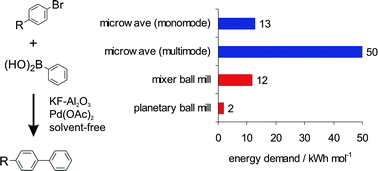Energetic assessment of the Suzuki–Miyaura reaction: a curtate life cycle assessment as an easily understandable and applicable tool for reaction optimization†
Abstract
The

* Corresponding authors
a
Institute for Technical Chemistry and Environmental Chemistry, Friedrich-Schiller University Jena, Lessingstr. 12, Jena, Germany
E-mail:
Bernd.Ondruschka@uni-jena.de
Fax: +49 (0)3641 948402
Tel: +49 (0)3641 948400
b Institute for Organic Chemistry, Technical University Braunschweig, Hagenring 30, Braunschweig, Germany
The

 Please wait while we load your content...
Something went wrong. Try again?
Please wait while we load your content...
Something went wrong. Try again?
F. Schneider, T. Szuppa, A. Stolle, B. Ondruschka and H. Hopf, Green Chem., 2009, 11, 1894 DOI: 10.1039/B915744C
To request permission to reproduce material from this article, please go to the Copyright Clearance Center request page.
If you are an author contributing to an RSC publication, you do not need to request permission provided correct acknowledgement is given.
If you are the author of this article, you do not need to request permission to reproduce figures and diagrams provided correct acknowledgement is given. If you want to reproduce the whole article in a third-party publication (excluding your thesis/dissertation for which permission is not required) please go to the Copyright Clearance Center request page.
Read more about how to correctly acknowledge RSC content.
 Fetching data from CrossRef.
Fetching data from CrossRef.
This may take some time to load.
Loading related content
